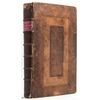77: Roman philosopher Pliny describes tally sticks
Numerical information recorded by notches carved in bone and wood




Notched and carved pieces of bone, ivory, stone, clay, and wood have been used to record numerical information for tens of thousands of years. The leg bone of a baboon found in a cave in the Lebombo Mountains of South Africa that has been carbon dated as more than 40,000 years old carries 29 distinct notches. Marks inscribed in three columns on the handle of the Ishango bone tool found in the Great Lakes region of present day Uganda were carved over 20,000 years ago.
The word tally stick to describe notched artifacts that include a detachable copy is derived from the Latin for twig “talea” and the French verb “tailler” to cut. Roman natural philosopher Pliny the Elder described the best wood for tally sticks in his Naturalis Historia encyclopedia published circa C.E. 77. Venetian merchant traveler Marco Polo (1254–1324) reported that otherwise illiterate residents of Zardandan in the modern Chinese province of Yunnan recorded business transactions by cutting notches in each half of a split stick. On settling accounts the creditor’s half was returned to the debtor.
Even after parchment and later paper became a more convenient means for recording such information, tally sticks remained in use because of their durability and security. It is difficult to falsify the unique patterns created. They found widespread use for storage of financial records in England where they are described in documents dating from circa 1180. Tax assessments were recorded on a wooden stick that was split down the middle so both parties held a durable record. A record written in ink accompanied each stick. To confirm payment, the two halves could be matched to ensure that they "tallied." The British Exchequer continued to use the split tally until 1826. Tallies remained in use by bakers and others in parts of England and France through the end of the 19th century.
Contemporary Documents
- Gaius Plinius Secundus. (Pliny the Elder) Naturalis Historia (AD 77–79)
- Dialogus de Scaccario: The Dialogue of the Exchequer, Oxford (c. 1180) p. xxvii
- Polo, Marco. The Travels of Marco Polo, Volume II (Translated by Sir Henry Yule & Henri Cordier in 1903) Dover Publications (1993) p. 86
- Thomas, Madox. The History and Antiquities of the Exchequer of the Kings of England, in two periods, London (1711)
More Information
- "Preserving Information" Revolution Exhibit Computer History Museum
- Baxter, T. W. "Early Accounting, The Tally and the Checkerboard" The Accounting Historians Journal (Vol. 16, 1989) pp. 43–83
- De Heinzelin, J. “Ishango” Scientific American (June 1962) pp. 105-116
- Jenkinson, Hilary. “Exchequer Tallies” Archaeologia, The Society of Antiquaries of London (Vol: 62, 1911) pp. 367-380
- "The Ishango Bone: Cradle of Ancient Mathematics" (Retrieved on 11.3.14 from: http://afrolegends.com/2013/08/29/the-ishango-bone-craddle-of-mathematics/)
Oral Histories
None identified
File name: 0077_Tally_v6
Rev 9.2.15


